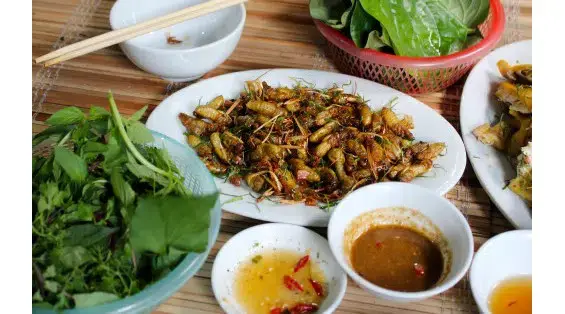It’s hard to believe that the cost of nitrogen fertilizer has tripled in the last year! Kyle...
Cicadas Can be a Tasty Treat – (TBD!)

Whether you call them bugs or even “shrimps of the land,” cicadas are among those insects that are safe to eat.
Trillions of periodical cicadas have begun emerging across multiple states as part of a rare, two-brood event. Known as Broods XIII and XIX, the periodical cicadas will continue to emerge from their underground habitats as the temperatures continue to warm over the next few weeks in 17 states across the Midwest and Southeast.
Broods XIII and XIX are part of 12 broods of periodical cicadas that emerge every 17 years, from mid-May to late June. What makes this year’s event even more significant is that these broods haven’t emerged together since 1803, and they won’t do so again until 2245, entomologists say.
The female cicadas lay hundreds of eggs in tree branches. After hatching, the nymphs fall to the soil and burrow underground, feeding on tree roots. Some 13 or 17 years later when they’re ready, the nymphs emerge from the soil, shed their skin, expand their wings, and harden and pigment their new exoskeleton. The males then sing to attract females, mate, and the females lay their eggs, starting the process over again, explains David Shetlar, a professor emeritus of entomology with Ohio State University Extension, the statewide outreach arm of The Ohio State University College of Food, Agricultural, and Environmental Sciences (CFAES).
“For those of you who are more adventurous, these cicadas can be a tasty treat,” Shetlar said. “These things are perfectly edible. They have the consistency of milk chocolate, with a mild, nutty flavor, like roasted almonds.
Shetlar said he’s seen people eat cicadas on top of cookies, and fry them and dip them in chocolate. He said for those who are wanting to try this delicacy, its best to get the nymphs as they emerge, typically best done about an hour or two after dark, which is their peak emergence time. They should be washed thoroughly and then frozen until ready to prepare.
“When ready to cook, quickly rinse them in water to thaw, then blot dry with a paper towel, snipping the legs off or leaving them on if you want,” Shetlar said. “Simply fry them in a pan with some butter, or toss in a little bacon or bacon fat for added flavor. Once they have been fried, they can be put into some pasta, rice, or put on a bed of greens. They will be just a little different than small popcorn shrimp.”
Shetlar said the teneral adults — those that have emerged from their nymphal skin — are white and haven’t expanded their wings. He said they’re soft and equivalent to soft-shell crab. They can also be fried or dipped in shrimplike batter and then fried.
In fact, if you’re looking for a recipe for stir-fried cicadas and rice, a recipe from The Ohio State University Wexner Medical Center can be found here. The site also details how to catch cicadas for consumption.
However, before you decide to indulge in your favorite cicada recipe, Shetlar said that it’s important to cook any insect collected in the wild and avoid eating it raw. “While there is little risk of any dangerous pathogens or parasites to be found in cicadas, there is always the slim risk of picking up something that you certainly don’t want to get by eating the cicadas raw,” he said.
Another precaution: If you have any shellfish allergies, you should avoid eating cicadas, the U.S. Food and Drug Administration has warned on the social platform X. “Don’t eat #cicadas if you’re allergic to seafood as these insects share a family relation to shrimp and lobsters,” the FDA wrote in the tweet.
Cicadas aren’t the only insects that are edible, says Ellen Klinger, a CFAES assistant professor of entomology. Cultures around the world routinely consume insects as part of their daily fare. “Emperor moth caterpillars, commonly called mopane worms, are a popular snack in South African countries,” she said. “Chapulines, roasted and seasoned grasshoppers, fill tacos in Mexico.”
“In China, silkworm moth pupae are canned and found on store shelves, providing a high-protein and high-fat food source that was also considered for use as a food source by astronauts,” says Klinger.
In many cases, insect foods provide higher protein and less fat than conventional meat sources, while requiring lower environmental inputs such as water and land, according to Klinger. “The lack of intentional insect consumption in the United States and other developed countries is actually quite unique,” she said. “Entomophagy — eating insects — is a cultural practice that has been lost in most of these countries.”
Source: Ohio State University CFAES
EDITOR’S TAKE:
Personally, I’ll leave bug consumption to others. They might be really tasty, but just not my style. I get it, other countries eat all types of alternative foods that most Americans would not consume on a bet. Having traveled in some of those countries and experienced their food – just give me a hamburger with lettuce, onion and tomato and let’s call it a day. Unless someone starts farming cicadas, I don’t think you will sell more trucks by having people switch to this bug diet. Instead, focus on the farmers and ranchers who do produce the high- quality food we typically find in the grocery store. Put your inventory on AgTruckTrader.com® so they can see what you have on your lot. In the meantime, eat cicadas if you like, but don’t wait for me to join you!








